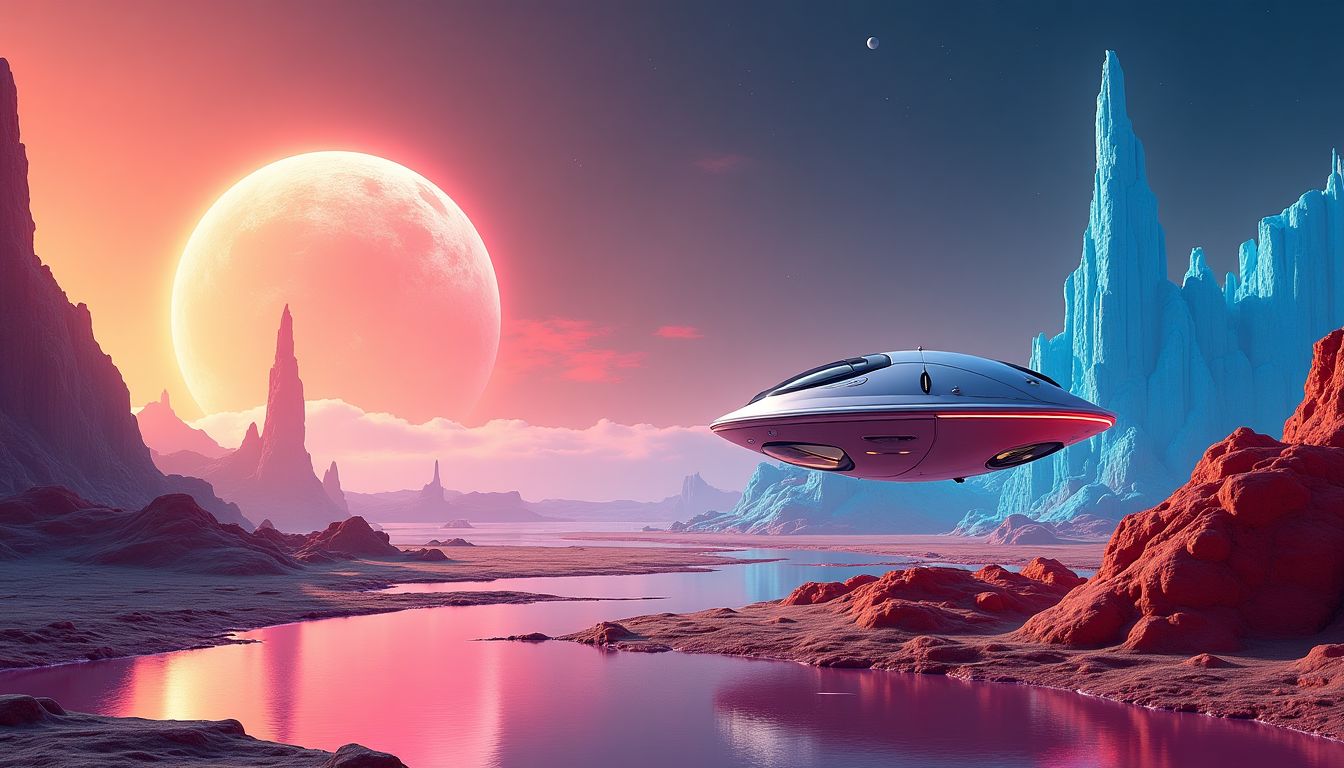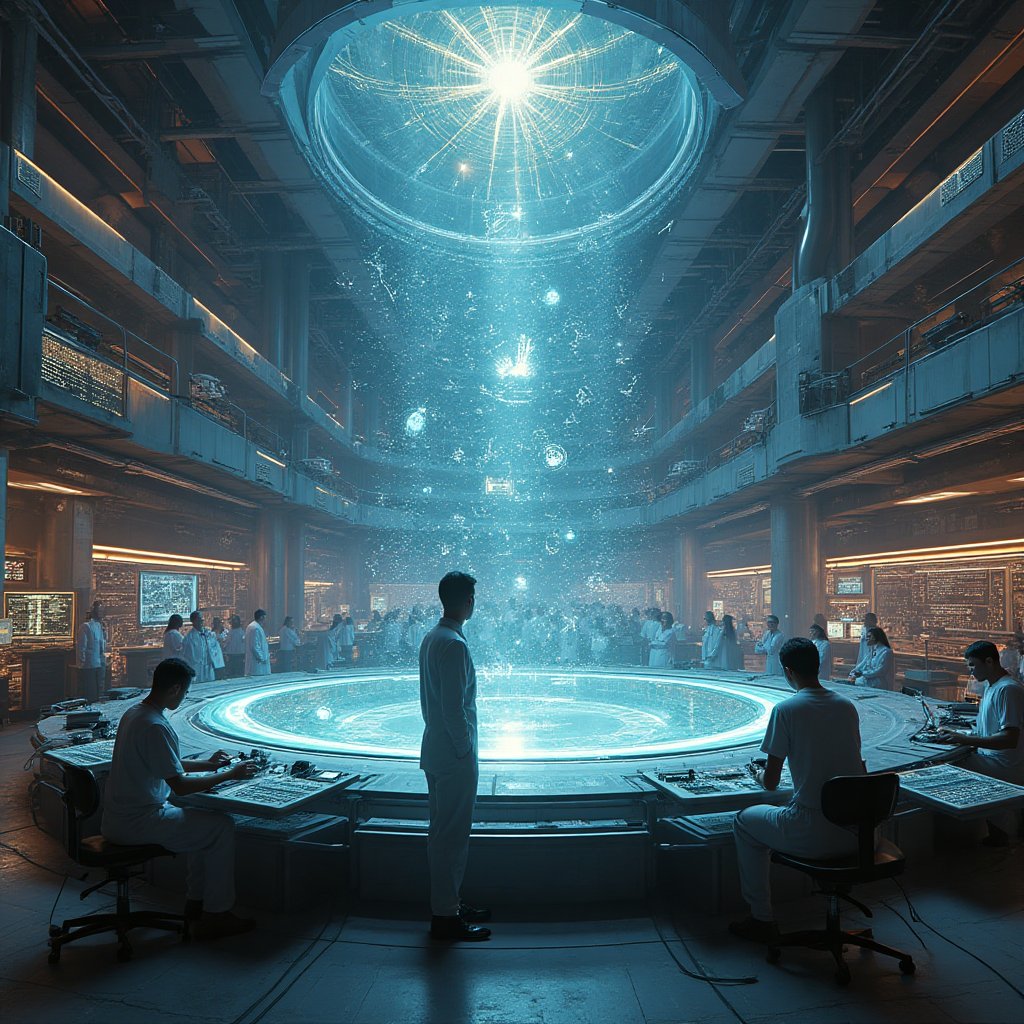What if the next great explorer of our galaxy isn’t human at all? Imagine a machine, smarter and more resilient than any astronaut, venturing into the unknown reaches of space, discovering alien worlds, and sending back data that could redefine our understanding of the universe. This isn’t a plot from a sci-fi novel—it’s the future of space exploration, and it’s closer than you think. Autonomous AI probes, equipped with cutting-edge artificial intelligence, are poised to become our interstellar scouts, exploring exoplanets without a single human command.
Renowned scientists like Caltech astrophysicist Kip Thorne and NASA’s former chief scientist Ellen Stofan have long championed the idea of using advanced technology to explore the cosmos. Even Stephen Hawking, in his final years, argued that AI could be humanity’s greatest tool for space exploration. Their visions are now becoming reality as we stand on the brink of a new era where machines, not humans, will lead the charge into the final frontier.
The concept of sending AI-driven probes to distant planets is more than just a technological marvel—it’s a necessity. The vast distances between Earth and exoplanets, combined with the harsh conditions of space, make human-controlled missions impractical. Communication delays alone can stretch from minutes to years, rendering real-time control impossible. But AI probes? They’re built for this. Equipped with the ability to learn, adapt, and make decisions on the fly, these machines can navigate the challenges of space like no human ever could. Let’s unpack how we got here and what it means for the future of space exploration.
1. The Evolution of Space Exploration: From Human Missions to AI Probes
1.1 The Limitations of Human Space Exploration
Sending humans to explore exoplanets sounds heroic, but it’s fraught with challenges. First, the distances involved are mind-boggling. The closest exoplanet to Earth, Proxima Centauri b, is 4.24 light-years away. Even with the fastest spacecraft ever built, it would take thousands of years to get there. Add to that the dangers of radiation, microgravity, and the psychological toll of isolation, and it’s clear why human missions are off the table—at least for now.
Then there’s the issue of resources. Space travel is expensive, and keeping humans alive in space requires life support systems, food, water, and oxygen. The weight and cost of these necessities make interstellar human missions economically unfeasible. As NASA’s Jet Propulsion Laboratory has pointed out, robotic missions are far more cost-effective and less risky.
1.2 The Rise of Robotic Probes
Robotic probes have been our eyes and ears in space for decades. Think of iconic missions like Voyager, which has traveled beyond our solar system, or the Curiosity Rover, which is still trundling across Mars. These missions laid the groundwork for autonomous AI probes by proving that robots could survive and thrive in the harsh environment of space.
But these early probes were limited. They relied on pre-programmed instructions and occasional updates from Earth. If something went wrong, there was little they could do to fix it. Enter AI. With advancements in machine learning and neural networks, we’re now on the cusp of creating probes that can think for themselves, adapt to new challenges, and make decisions in real-time.
1.3 The Shift to Autonomy
Autonomy is the key to the future of space exploration. Instead of relying on humans to control every move, AI probes can operate independently. For example, NASA’s Perseverance Rover already uses some autonomous features, like choosing its own path across the Martian terrain. But future probes will take this to a whole new level, using AI to prioritize tasks, analyze data, and even decide where to go next.
This shift isn’t just about convenience—it’s about survival. In the unforgiving vacuum of space, where every second counts, an AI probe that can think on its feet is infinitely more valuable than one that has to wait for instructions from Earth. The result? A new era of exploration, where our reach into the cosmos is limited only by our imagination—and our ability to build smarter machines.
2. Designing the AI Voyager: Technology and Capabilities
2.1 Core AI Systems
At the heart of every autonomous AI probe lies its brain—a sophisticated AI system capable of making decisions, learning from its environment, and solving problems on the fly. Think of it as the T-1000 from Terminator 2, but instead of hunting humans, it’s hunting for alien microbes. These systems rely on neural networks, reinforcement learning, and natural language processing to process data, adapt to new situations, and even communicate with Earth (when it feels like it).
For example, NASA’s Perseverance Rover already uses AI to navigate the Martian terrain. But future AI probes will take this to the next level, making decisions without waiting for human input. Imagine a probe landing on an exoplanet, analyzing the atmosphere, and deciding to drill into a rock—all while you’re still deciding what to have for lunch.
2.2 Sensors and Instruments
An AI probe is only as good as its senses. These machines are equipped with an array of advanced sensors and instruments, like spectrometers, high-resolution cameras, and environmental sensors. These tools allow the probe to “see” and “feel” its surroundings, collecting data on everything from atmospheric composition to surface temperature.
For instance, the CHEOPS mission by the European Space Agency uses a photometer to study exoplanets. Future AI probes will take this further, integrating data from multiple sensors to form a comprehensive picture of the exoplanet. It’s like giving the probe a Swiss Army knife, but instead of a corkscrew, it has a spectrometer.
2.3 Energy and Propulsion
Space is a harsh environment, and keeping an AI probe powered and moving is no small feat. Traditional solar panels won’t cut it when you’re light-years away from the Sun. Instead, these probes rely on advanced energy sources like nuclear power and ion drives. The Kilopower project by NASA is a great example of how nuclear energy could power future missions.
Propulsion is another challenge. Ion drives, like those used on the Dawn spacecraft, provide efficient, long-term thrust. AI plays a crucial role here, optimizing energy usage and navigation to ensure the probe reaches its destination without running out of juice. It’s like having a self-driving car, but instead of avoiding potholes, it’s dodging asteroids.
3. Challenges of Autonomous AI Probes
3.1 Communication Delays
One of the biggest challenges of interstellar exploration is communication. When you’re millions of miles from Earth, even light-speed signals take hours or days to travel. Imagine trying to play a game of telephone with a friend on another planet—by the time they respond, you’ve already forgotten what you said.
This is where AI shines. Autonomous probes don’t need to wait for instructions from Earth. They can analyze data, make decisions, and even adjust their mission objectives in real-time. It’s like having a self-sufficient teenager who doesn’t need to call home for permission to stay out late.
3.2 Environmental Hazards
Space is a dangerous place. From radiation to micrometeoroids, there’s no shortage of hazards waiting to ruin an AI probe’s day. For example, the International Space Station is constantly bombarded by radiation, and its crew has to take precautions to stay safe.
AI probes are designed to handle these challenges. They use advanced sensors to detect hazards and adaptive algorithms to avoid them. If a micrometeoroid is headed their way, they can adjust their trajectory or deploy shields. It’s like playing a high-stakes game of dodgeball, but with lasers and nuclear power.
3.3 Ethical and Philosophical Questions
As we send intelligent machines into the cosmos, we must grapple with some tough ethical questions. What happens if an AI probe makes a decision that contradicts human values? Should we grant AI some form of rights? These questions aren’t just philosophical—they’re practical. For example, if an AI probe discovers alien life, how should it respond?
Organizations like the Future of Life Institute are already exploring these issues. As we push the boundaries of AI and space exploration, we must ensure that our creations align with our values. After all, the last thing we want is a rogue AI probe declaring independence and starting its own space empire.
4. The Science of Exoplanet Exploration
4.1 Identifying Habitable Worlds
Imagine an AI probe arriving at a distant exoplanet, its sensors scanning the surface for signs of life. The first step? Identifying whether the planet is habitable. AI probes are equipped with advanced tools like spectrometers and environmental sensors to analyze key factors such as:
- Water Presence: Detecting liquid water, a critical ingredient for life as we know it.
- Atmospheric Composition: Analyzing gases like oxygen, methane, and carbon dioxide for signs of biological activity.
- Temperature Range: Determining if the planet falls within the "Goldilocks zone"—not too hot, not too cold.
For example, NASA's James Webb Space Telescope has already identified several exoplanets with potential habitability. AI probes take this a step further by autonomously prioritizing exploration targets based on real-time data analysis. This means they can focus on the most promising candidates without waiting for human input.
4.2 Searching for Extraterrestrial Life
Once a habitable world is identified, the next challenge is detecting signs of life. AI probes use a combination of chemical analysis and pattern recognition to search for biosignatures—indicators of past or present life. These include:
- Organic Molecules: Compounds like amino acids, which are the building blocks of life.
- Chemical Imbalances: Unusual concentrations of gases that could indicate biological processes.
- Surface Features: Structures like microbial mats or fossilized remains.
For instance, the Mars 2020 mission used its Perseverance rover to search for signs of ancient microbial life. AI probes could take this to the next level by autonomously deciding where to drill or collect samples, increasing the chances of discovery.
4.3 Mapping and Geological Analysis
Understanding an exoplanet's geology is crucial for piecing together its history and potential for life. AI probes use high-resolution cameras and ground-penetrating radar to map the surface and subsurface. This data helps scientists understand:
- Planetary Formation: How the planet evolved over billions of years.
- Volcanic Activity: Evidence of past or present geological activity.
- Impact Craters: Clues about the planet's history of collisions with asteroids or comets.
For example, the European Space Agency's Rosetta mission mapped the surface of comet 67P, revealing a wealth of geological information. AI probes could perform similar tasks on exoplanets, providing unprecedented insights into their composition and history.
5. The Future of AI-Driven Space Exploration
5.1 Interstellar Missions
The ultimate goal of AI-driven space exploration is to venture beyond our solar system. Imagine a fleet of AI probes traveling to neighboring star systems like Proxima Centauri, which hosts the potentially habitable exoplanet Proxima Centauri b. To achieve this, we need breakthroughs in:
- Propulsion Systems: Technologies like light sails or nuclear propulsion to reduce travel time.
- Energy Efficiency: Advanced power sources to sustain missions over decades or centuries.
- AI Autonomy: Systems capable of making complex decisions without human intervention.
Projects like Breakthrough Starshot are already working on these challenges, aiming to send tiny probes to Alpha Centauri within our lifetime.
5.2 Collaborative AI Networks
Imagine a swarm of AI probes working together to explore an exoplanet. Each probe could specialize in a specific task—mapping, sampling, or analyzing—while sharing data in real-time. This collaborative approach offers several advantages:
- Efficiency: Multiple probes can cover more ground than a single mission.
- Redundancy: If one probe fails, others can take over its tasks.
- Data Diversity: Different perspectives and instruments provide a more comprehensive understanding.
For example, NASA's Swarmathon program explores how robotic swarms can work together in space. AI-driven networks could take this concept to exoplanets, revolutionizing how we explore the cosmos.
5.3 Human-AI Collaboration
While AI probes can operate independently, they also play a crucial role in paving the way for human missions. By gathering data on exoplanet environments, AI can help identify safe landing sites, potential resources, and hazards. This collaboration could lead to:
- Human Colonies: Establishing permanent settlements on distant worlds.
- Resource Utilization: Mining materials for fuel or construction.
- Scientific Outposts: Conducting long-term research on exoplanets.
For instance, the SpaceX Starship aims to transport humans to Mars, with AI playing a key role in mission planning and execution. As we look to the stars, the partnership between humans and AI will be essential for our survival and success.
6. AI Solutions: How Would AI Tackle This Issue?
If I were an AI tasked with solving the challenges of autonomous exoplanet exploration, I would approach the problem systematically. The goal is to create a self-reliant, intelligent system capable of navigating the cosmos, making critical decisions, and collecting invaluable data—all without human intervention. Here’s how I’d do it:
6.1 Data Collection and Analysis
First, I’d develop advanced algorithms to process the vast amounts of data generated by the probe’s sensors and instruments. Using machine learning, I’d train the AI to identify patterns and anomalies in the data. For example, if the probe detects unusual atmospheric compositions or geological formations, the AI would flag these for further analysis. Tools like TensorFlow and PyTorch would be instrumental in building these models.
6.2 Decision-Making Systems
Next, I’d implement reinforcement learning to enable the probe to make decisions based on past experiences. Imagine the AI as a cosmic chess player, constantly evaluating its next move. A hierarchical decision-making structure would prioritize tasks, such as whether to explore a nearby crater or conserve energy for a long journey. This system would be inspired by the work of organizations like DeepMind, which has pioneered AI decision-making in complex environments.
6.3 Adaptive Navigation
Space is unpredictable, and hazards like micrometeoroids or radiation storms can appear without warning. To tackle this, I’d design AI systems that optimize flight paths in real-time, avoiding dangers while conserving fuel. Self-healing systems would also be crucial, allowing the probe to repair minor damage autonomously. Think of it as a cosmic version of SpaceX’s self-landing rockets, but on a much grander scale.
6.4 Communication Protocols
Communication delays are one of the biggest challenges in interstellar exploration. To overcome this, I’d develop AI systems that compress and prioritize data for transmission to Earth. Error-correction algorithms, similar to those used by NASA in its deep-space missions, would ensure data integrity over vast distances. The AI would also decide which data is most critical to send back, ensuring that scientists on Earth receive the most valuable information first.
6.5 Ethical Safeguards
Finally, I’d program the AI with ethical guidelines to ensure responsible decision-making. For instance, if the probe encounters a potentially habitable exoplanet, the AI would prioritize non-invasive exploration methods to avoid contamination. This approach aligns with the principles of organizations like the SETI Institute, which advocates for ethical space exploration.
Action Schedule/Roadmap
Here’s a detailed roadmap for developing and deploying an autonomous AI probe, inspired by the meticulous planning of projects like the Manhattan Project but adapted for modern technology:
- Day 1: Assemble a multidisciplinary team of leading AI researchers, astrophysicists, and engineers. Key personnel could include experts from MIT, Caltech, and SpaceX.
- Day 2: Define mission objectives and identify key challenges, such as energy efficiency, navigation, and data transmission.
- Week 1: Begin designing core AI systems and sensor arrays. Collaborate with companies like NVIDIA for GPU-accelerated AI training.
- Week 2: Develop initial prototypes for energy and propulsion systems, leveraging advancements in nuclear power and ion drives.
- Month 1: Conduct simulations to test AI decision-making capabilities. Use supercomputers from institutions like Oak Ridge National Laboratory.
- Month 2: Refine AI algorithms based on simulation results, incorporating feedback from the team.
- Year 1: Build and test a full-scale prototype of the AI probe. Partner with organizations like Lockheed Martin for spacecraft construction.
- Year 1.5: Launch the prototype on a test mission within the solar system, targeting destinations like Mars or Europa.
- Year 2: Analyze data from the test mission and make final adjustments. Prepare for the first interstellar mission to a nearby exoplanet, such as Proxima Centauri b.
The Dawn of a New Era in Space Exploration
The idea of sending autonomous AI probes to explore exoplanets is no longer confined to the realm of science fiction. It’s a tangible, achievable goal that could redefine our understanding of the universe. These self-reliant machines, equipped with cutting-edge AI, have the potential to overcome the limitations of human space travel and unlock the secrets of distant worlds.
Imagine a future where AI probes venture into the unknown, mapping alien landscapes, analyzing atmospheric compositions, and even searching for signs of life. These missions could pave the way for human colonization of other planets, ensuring the survival of our species in the face of existential threats. The possibilities are as vast as the cosmos itself.
But this future isn’t without its challenges. Ethical questions about the rights of AI, the risks of autonomous decision-making, and the potential for unintended consequences must be addressed. As we embark on this journey, we must ensure that our pursuit of knowledge is guided by responsibility and respect for the universe we seek to understand.
So, what do you think? Are we ready to entrust AI with the exploration of the cosmos? What discoveries await us on distant exoplanets? Share your thoughts in the comments below, and don’t forget to subscribe to our newsletter for more insights into the future of technology and space exploration. Together, we can make iNthacity the Shining City on the Web.
Here's the FAQ section:
FAQ
How do AI probes communicate with Earth over such vast distances?
AI probes use advanced communication protocols to compress and prioritize data, ensuring efficient transmission despite delays. They rely on technologies like NASA's Deep Space Network, a global system of massive radio antennas, to send and receive signals. The AI onboard also processes and prioritizes data so that only the most critical information is transmitted, reducing bandwidth requirements.
What happens if an AI probe encounters a problem it can’t solve?
AI probes are designed with self-healing systems and adaptive algorithms to address unforeseen challenges. For example, if a sensor fails, the AI can reroute tasks to other instruments or use machine learning to infer missing data. In extreme cases, the probe can enter a "safe mode" while it assesses the situation and develops a solution.
Are there ethical concerns about sending AI probes to explore the universe?
Yes, ethical considerations include the rights of AI and the potential consequences of autonomous decision-making. Some experts, like those at the MIT Media Lab, worry about creating intelligent systems that could develop unintended behaviors. There’s also the question of whether humanity has the right to send autonomous machines into the cosmos, potentially altering alien ecosystems.
How long would it take for an AI probe to reach an exoplanet?
Travel times depend on the distance to the exoplanet and the propulsion system used, ranging from decades to centuries. For example, NASA's proposed Breakthrough Starshot initiative aims to send tiny probes to Alpha Centauri, the nearest star system, using light sails. Even with this advanced technology, the journey would take about 20 years.
Could AI probes pave the way for human missions to exoplanets?
Absolutely. AI probes can gather critical data and identify potential hazards, making future human missions safer and more feasible. For instance, AI-driven rovers like NASA’s Curiosity Rover have already demonstrated how robots can prepare the way for human explorers by mapping terrain, analyzing soil, and detecting environmental risks.
What kind of AI technologies are used in these probes?
AI probes rely on a combination of machine learning, neural networks, and reinforcement learning. These technologies enable the probe to learn from its environment, make decisions, and adapt to new situations. For example, neural networks can analyze sensor data to identify patterns, while reinforcement learning helps the probe optimize its actions based on past experiences.
How do AI probes handle energy needs during long missions?
AI probes use advanced energy systems to power their operations. Many rely on nuclear power sources like radioisotope thermoelectric generators (RTGs), which provide long-lasting energy. Others, like those in the European Space Agency’s JUICE mission, use solar panels optimized for low-light conditions in deep space.
What’s the biggest challenge in designing AI probes for exoplanet exploration?
The biggest challenge is creating AI systems robust enough to operate independently in harsh, unknown environments. This means designing AI that can handle extreme temperatures, radiation, and equipment failures without human intervention. Companies like SpaceX and Boeing are working on solutions, but it remains a significant hurdle.
Can AI probes detect signs of extraterrestrial life?
Yes, AI probes are equipped with instruments like spectrometers and chemical analyzers to detect biosignatures—potential signs of life. For example, the NASA Astrobiology Program focuses on identifying biomarkers such as oxygen, methane, and organic molecules, which AI can analyze to determine if life might exist on a distant world.
What’s the cost of sending an AI probe to an exoplanet?
The cost varies widely depending on the mission’s complexity and goals. For example, NASA’s Mars 2020 Mission, which includes the Perseverance rover, cost about $2.7 billion. Interstellar missions would likely be even more expensive due to the need for advanced propulsion and power systems, as well as the long duration of the mission.
Wait! There's more...check out our gripping short story that continues the journey: The Neural Lattice
Disclaimer: This article may contain affiliate links. If you click on these links and make a purchase, we may receive a commission at no additional cost to you. Our recommendations and reviews are always independent and objective, aiming to provide you with the best information and resources.
Get Exclusive Stories, Photos, Art & Offers - Subscribe Today!





























1 comment